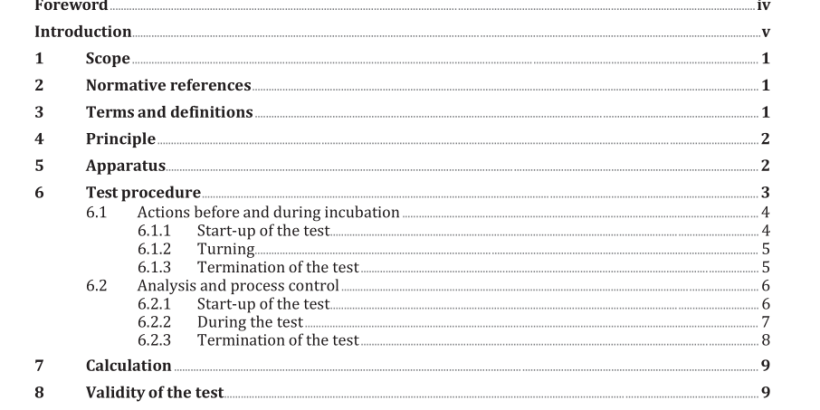ISO 16929:2021 pdf download – Plastics — Determination of the degree of disintegration of plastic materials under defined composting conditions in a pilot-scale test.
5.1.2 Composting bins 5.1.2.1 Volume and material The bins shall: — have a minimum volume of 35 l; — consist of a sturdy, heat-resistant and non-biodegradable material; — not affect the composting process or the quality of the compost. 5.1.2.2 Drainage The drainage shall consist of a layer of drains with a thickness of at least 5 cm at the bottom of the bins. 5.1.3 Sample nets, if used, shall consist of mesh-like material with a mesh size of 1 mm made of non- degradable plastic which is resistant to temperatures up to 120 °C. The minimum volume shall be 20 l. 5.2 Apparatus for temperature measurement. 5.3 pH-meter. 5.4 Apparatus for oxygen measurement. 5.5 Sieves, of suitable shape with screens of 2 mm and 10 mm mesh (as specified, for example, in ISO 3310-2).
6 Test procedure WARNING — Compost can contain potentially pathogenic organisms. Therefore, appropriate precautions should be taken when handling it. Aspergillosis, farmer ’s lung, histoplasmosis, Legionnaire ’s disease, paronychia and tetanus are some of the more common physical ailments that can result from unprotected contact with compost. The following general safety precautions should be followed in order to avoid transmission of dangerous fungi, bacteria and other pathogens found in compost. — Always wear gloves to avoid direct contact with the skin. — Always wear protective footwear that covers your skin adequately. — When stirring and tilling the compost, which is required on a regular basis in order for it to process and break down, always wear a nose and mouth guard or dust mask to avoid inhaling the various spores that will become airborne during tilling and turning. — Do not store compost in fully closed or airtight containers. — Always wash your hands after dealing with compost.
6.1 Actions before and during incubation 6.1.1 Start-up of the test 6.1.1.1 Preparation of biowaste As a carrier matrix, use biowaste, if possible from the input material of a composting plant treating predominantly municipal waste, or, less satisfactorily, biowaste directly from households or grocery stores for example. NOTE be used: Alternatively, a representative artificial biowaste with, for example, the following ingredients can — — — — — freshly mixed fruit and vegetable waste; rabbit feed (seeds and extruded dried-vegetable pellets); mature compost; sufficient water to attain a good moisture content; a bulking agent (such as wood chips or bark). It is important that for all test series a homogeneous biowaste of the same age and origin is used. Reduce the biowaste to particle sizes of maximum 50 mm, for example by shredding or sieving. Depending on the type of waste, add about 100 g/kg to 600 g/kg of bulking agent (structurally stable components such as wood chips or bark with a particle size between 10 mm and 50 mm). To ensure a good composting process, the biowaste shall meet the following criteria: — the C:N ratio of the fresh biowaste/bulking agent mixture shall be between 20 and 30; — the moisture content shall be above 50 % mass fraction, with no free water present; — the volatile solids content of the total dry solids shall be above 50 % mass fraction; — the pH shall be above 5. Adjust the C:N ratio with urea, if required.
6.1.1.4 Mixing ratio of biowaste and test material Conduct each composting test series with roughly the same amount of biowaste (wet mass minimum 15 kg). The amount of test material to be added shall be as follows. a) For measurement of the degree of disintegration and compost analysis [see 6.1.1.2 a)]: — 10 g/kg of test material in its final form. b) For measurement of the degree of disintegration, compost analysis and ecotoxicity tests in one test series [see 6.1.1.2 a) and b)]: — 10 g/kg of test material in its final form; — and 90 g/kg of test material as powder or granules. c) For the optional ecotoxicity tests in separate test series [see 6.1.1.2 b)]: — 100 g/kg as powder or granulate. 6.1.1.5 Preparation of samples The biowaste used shall be a randomly taken homogeneous and representative sample. Prepare each test series separately. For all series with test material, weigh biowaste and test material precisely and mix well before introducing into the bin. If sample nets are used in the composting bins, put the input of biowaste from each sample into a container, weigh and subsequently mix thoroughly with the test material which shall be added in the ratios specified in 6.1.1.4. Place the mixture of biowaste and test material in the nets, tie the nets up tightly with non-biodegradable and heat-resistant plastic string and mark them appropriately.
